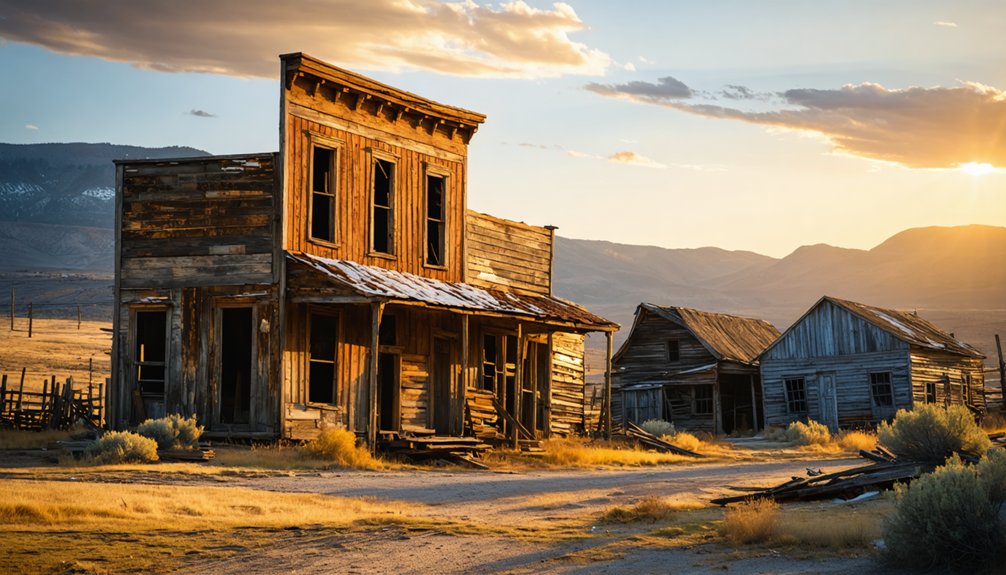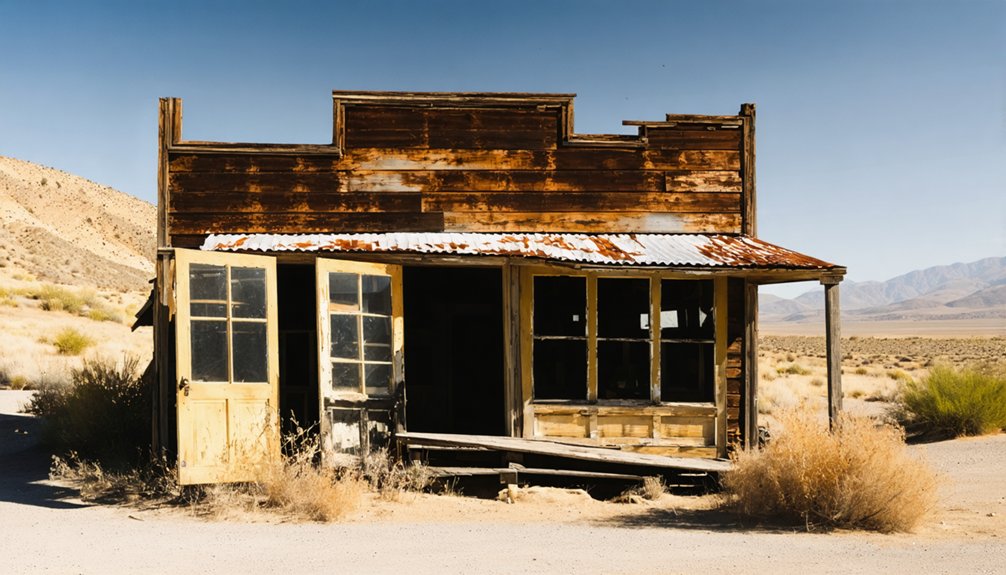You’ll find Czizek in Idaho County, a ghost town that briefly thrived around the Golden Anchor Mine. The settlement got its start with a post office opening in September 1940, named after mining expert Jay A. Czizek from Michigan. Despite the mine’s impressive production of $289,222 in gold and silver between 1902-1928, the town only lasted until May 1942. The site’s remnants offer fascinating glimpses into Idaho’s mining heritage and frontier spirit.
Key Takeaways
- Czizek was a short-lived mining town in Idaho County, established in 1940 and centered around the Golden Anchor Mine.
- The town’s post office operated from September 27, 1940 to May 3, 1942, marking its brief official existence.
- Mining operations focused on gold and silver extraction, with the Golden Anchor becoming Idaho’s highest-producing gold mine in 1917.
- The site, located at 6,499 feet elevation, is now abandoned with minimal remains, exemplifying Idaho’s ghost town mining heritage.
- Workers faced harsh living conditions and 12-hour shifts, with a diverse population including Austrian and Chinese residents.
The Birth of a Mining Settlement
While many Idaho mining settlements sprang up during the late 19th century gold rushes, Czizek emerged later as a mining town centered around the Golden Anchor Mine in Idaho County.
You’ll find its official beginnings marked by the opening of a post office on September 27, 1940, though mining activities in the area existed well before that date.
The settlement challenges were significant, as you’d expect in Idaho’s rugged terrain. Originally from Mount Clemens, Michigan, the town’s namesake brought his expertise in mining operations to the region. The area was under the jurisdiction of the Challis Field Office, which oversaw numerous mining claims in the district.
Life in early Idaho mining towns tested the hardiest souls, with untamed wilderness and mountainous landscapes creating constant obstacles.
Mining logistics relied heavily on river freight boats, with early supply runs taking up to 10 days to deliver 7,000 pounds of cargo.
Under the watchful eye of Jay A. Czizek, who served as a mine manager and later state mine inspector, the settlement grew to include essential infrastructure like mills, sawmills, and boarding houses needed to support the mining operations.
Life at Golden Anchor Mine
You’d find the Golden Anchor miners working underground in vein deposits, extracting gold, silver, and other valuable minerals through challenging manual labor.
The mine’s installation of a mill in 1916 modernized operations, allowing for more efficient ore processing and higher yields that quickly recovered the equipment’s costs.
While specific details about workers’ living conditions remain limited, you’d likely see miners residing in basic accommodations near the mine site, forming a close-knit community shaped by their remote location and shared experiences. During its peak in 1917, Golden Anchor became Idaho’s highest-producing gold mine. Located in the Marshall Lake District, the mine’s strategic position supported its successful operations.
Daily Mining Operations
Deep within the Marshall Lake District of Idaho County, daily life at the Golden Anchor Mine centered around extracting precious metals from narrow quartz bodies during its peak production years of 1916-1918.
You’d find miners working underground at 6,499 feet elevation, following the east-striking lodes that dipped southward. Daily schedules revolved around the mill, which proved so efficient it paid for itself within the first month of operation. Detailed aerial photographs helped surveyors map the mining terrain and plan operations effectively.
Operational challenges included traversing the complex geology of schistose Belt rocks and dealing with post-mineral faulting that affected the lode structures. Historical records show the district merged with Warren for a total production of gold and silver $289,222 between 1902 and 1928.
You’d encounter a mix of valuable minerals while mining: metallic gold, argentiferous tetrahedrite, chalcopyrite, pyrite, sphalerite, and galena.
The underground vein mining operation continued successfully until national gold mining shutdowns forced periodic suspensions.
Workers’ Living Conditions
Life at the Golden Anchor Mine presented harsh realities typical of remote mining settlements in early 20th century Idaho.
You’d have found yourself facing significant housing challenges, with basic accommodations that offered minimal protection from the elements. Worker health concerns were constant, as you’d breathe in dust and face daily risks of accidents without adequate healthcare facilities nearby. Miners typically endured twelve-hour work shifts each day. Modern miners like Tim Wolfe now utilize solar-powered amenities for basic comfort.
The isolation of the mine meant you’d rely heavily on your fellow miners for support and companionship. While the job provided necessary income, you’d contend with long hours, hazardous conditions, and limited access to amenities.
The surrounding environment suffered too – the mining activities polluted local water sources and degraded air quality, directly impacting your living conditions.
Despite these challenges, the tight-knit community formed bonds through shared hardships.
Post Office Operations and Community Services
When Czizek established its post office at the Golden Anchor Mine on September 27, 1940, it marked an important milestone in the town’s development.
You’ll find the postal service played a significant role in maintaining community cohesion, serving as both a communication hub and social gathering point for miners and residents.
The post office’s operations, however, proved short-lived. Despite its importance for delivering critical supplies and mail in this remote location, the facility closed on May 3, 1942 – less than two years after opening.
Despite serving as a vital lifeline for this remote mining community, Czizek’s post office operated for only twenty months before shuttering permanently.
Like many Idaho mining communities, Czizek’s postal operations faced significant challenges, including treacherous mountain roads and harsh terrain. The onset of WW2 ultimately forced the mine and post office to close as the operation was deemed non-essential.
Similar to the Gilmore ghost town that saw its post office close in 1957, the end of postal services often signaled a community’s decline.
The post office’s closure accelerated the town’s decline, as it typically meant the loss of other important services like general stores and stagecoach stops, hastening Czizek’s shift to ghost town status.
Mining Operations and Economic Impact
You’ll find the most significant mining activity in Czizek centered around the Golden Anchor Mine, though detailed production records remain scarce.
The operation attracted investment from the United Verde Extension Mining Company of Jerome, Arizona in the 1930s, suggesting some economic potential during that period.
While the exact workforce numbers aren’t documented, the mine’s operations were likely modest compared to Idaho’s major mining districts, which often employed thousands of workers.
Golden Anchor Mine Operations
Located at an elevation of 6,499 feet in Idaho County, the Golden Anchor Mine emerged as a significant underground operation that primarily extracted gold and silver, while also yielding valuable deposits of lead, copper, zinc, tungsten, and molybdenum.
You’ll find that mining technology at the site centered around a 12-stamp mill, which processed ore extracted from five distinct veins running through metamorphic rock formations including schist, quartzite, and gneiss.
Discovered in 1914, the mine’s ore extraction methods focused on accessing these veins through a network of shafts and drifts.
While production volumes weren’t extensively documented, the operation maintained modest output compared to other regional mines until its closure in the mid-20th century.
Economic Scale and Workforce
The economic reach of Czizek’s Golden Anchor Mine extended far beyond its ore production, fitting into Idaho’s broader mining landscape that generated over $54 million in mineral value by 1917.
You’ll find that economic development in mining towns like Czizek reflected the boom-and-bust cycles that characterized Idaho’s mining history, with significant shifts occurring after World War I.
Labor dynamics at mines like Golden Anchor were shaped by the era’s workforce patterns. While Chinese miners made up a substantial portion of Idaho’s mining workforce by 1868, with over 4,000 workers contributing to various operations, the specific ethnic makeup of Czizek’s workforce varied as labor needs evolved.
The completion of regional railroads and improved transportation infrastructure helped sustain the mine’s operations and workforce mobility.
Daily Life in a Remote Mining Town

While mining operations largely influenced the economic landscape of Czizek, daily life in this remote Idaho town revolved around a complex web of social and practical considerations.
You’d find a primarily male population living in simple structures built from local materials, where community cooperation was essential for survival in the harsh mountain environment.
The cultural dynamics were shaped by diverse immigrant groups, including Austrian railway workers and Chinese miners who maintained their traditional ways while contributing to the town’s character.
- Housing ranged from basic boarding houses to family dwellings, clustered near mine operations.
- Socializing centered around communal spaces like saloons and boarding houses.
- Chinese residents operated essential services including laundries and pharmacies.
- Daily life required self-reliance due to limited amenities and challenging weather conditions.
The Final Days of Czizek
During its brief existence from 1940 to 1942, Czizek epitomized the fleeting nature of Idaho’s mining communities, marked by the establishment and swift discontinuation of its post office at the Golden Anchor Mine.
The final days of Czizek came as World War II redirected resources and labor away from small mining operations.
You’ll find that Czizek’s decline followed a familiar pattern: as the mine’s profitability waned, residents quickly abandoned the settlement.
Unlike other Idaho ghost towns that left substantial remains, Czizek’s structures were dismantled or relocated, leaving minimal traces of its existence.
Today, you won’t find much evidence of the town beyond sparse archaeological remnants at the former Golden Anchor Mine site.
Czizek’s rapid disappearance reflects the harsh realities faced by single-resource communities in early 20th-century Idaho.
Legacy and Historical Significance

Despite its brief two-year existence, Czizek holds significance as a symbol of Idaho’s mid-20th-century mining operations and economic development.
A short-lived mining settlement, Czizek exemplifies Idaho’s determined push toward industrial growth during the post-war years.
You’ll find that this ghost town, centered around the Golden Anchor Mine, represents a unique chapter in the state’s mining heritage. While it didn’t achieve the prominence of 19th-century boomtowns, Czizek’s remnants contribute to Idaho’s cultural heritage and ghost town tourism industry.
- Archaeological remains offer insights into 1940s mining technology and community life
- The town’s short lifespan illustrates the boom-and-bust cycle common in resource-dependent settlements
- Czizek adds to Idaho’s broader narrative of frontier spirit and industrial development
- The site joins other ghost towns in preserving the state’s mining legacy for future generations
Frequently Asked Questions
Are There Any Remaining Structures or Ruins Visible at Czizek Today?
Ever wonder what remains of Idaho’s forgotten past? You’ll find abandoned mine and mill buildings at this ghost town, though they’re deteriorating and lack the historical significance of better-preserved sites nearby.
What Specific Minerals or Metals Were Mined at the Golden Anchor Mine?
You’ll find that the Golden Anchor’s mineral extraction focused primarily on gold and silver, with secondary metals including lead and copper, plus tertiary minerals like zinc, tungsten, and molybdenum.
How Did Workers Access Czizek During Winter Months?
You’d access the town through snowmobiles, tracked ATVs, or cross-country skis during winter transportation challenges. The heavy snowfall of 4-6 feet made conventional vehicles impossible from November through June.
Were There Any Notable Accidents or Disasters at the Mine?
You won’t find records of major mine incidents at Czizek, though nearby Sunshine Mine’s 1972 disaster led to stricter safety regulations throughout Idaho’s mining industry.
Did Any Families With Children Live in Czizek?
You won’t find documented evidence of family life or childhood experiences in Czizek. Given its brief two-year existence as a mining camp, it’s unlikely families with children established permanent homes there.
References
- https://pinintheatlas.com/travel-blogs/ghost-towns-of-idaho/
- https://idaho-forged.com/idahos-ghost-towns-eerie-yet-approachable/
- https://visitidaho.org/things-to-do/ghost-towns-mining-history/
- https://history.idaho.gov/wp-content/uploads/2018/08/0064.pdf
- https://www.youtube.com/watch?v=qETuUsWjeW8
- https://ns1.ghosttowns.com/states/id/czizek.html
- https://en.wikipedia.org/wiki/List_of_ghost_towns_in_Idaho
- https://www.atlasobscura.com/places/burke-ghost-town
- https://accessgenealogy.com/colorado/biography-of-jay-a-czizek.htm
- https://www.idahogeology.org/pub/Bulletins/B-22.pdf



